#korean joseon period
Text






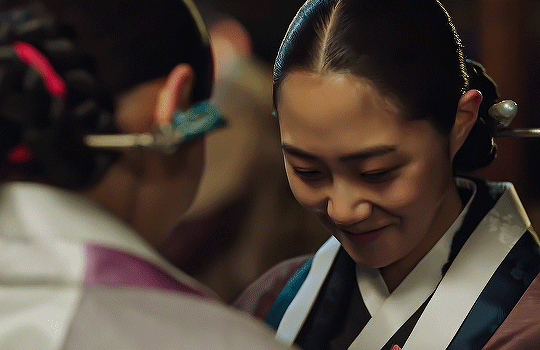
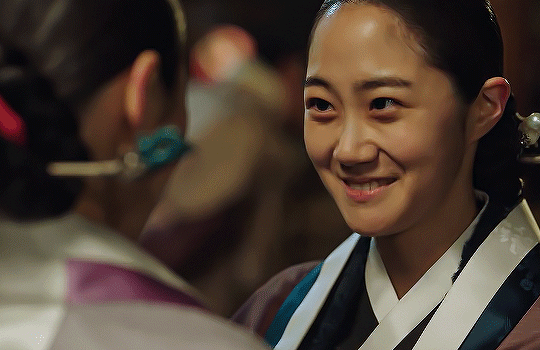
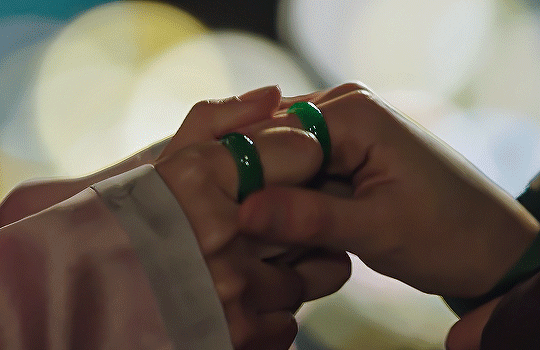
Your ring. You and Seol Ah each have a pair. They signify your love. I cannot go back to Seol Ah. Rather than being caught in a despicable scandal, she is better off forgetting about me.
Whether you run away, take on the challenge or scream, being together while you breathe... what is precious is the time you spend together. It will be over once you are gone, so why will you not muster up the courage? The courage to be with the one you love.
#poong the joseon psychiatrist#kdramaedit#asiandramaedit#asianlgbtqdrama#poongedit#prangon gifs#sapphics in my korean period drama?
64 notes
·
View notes
Text






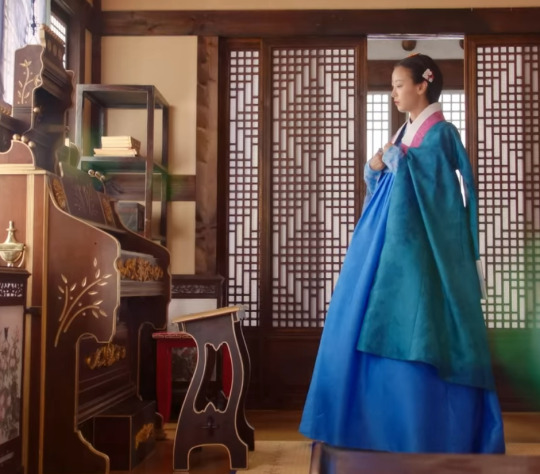
One Dress a Day Challenge
July: Blue Redux (+ Green Redux)
Flower Crew: Joseon Marriage Agency (episode 7) / Ko Won-hee as Kang Ji-hwa
This is a rare example for this show of a (mostly) single-color hanbok, with the jacket and skirt both being sky-blue. Usually, they are in contrasting colors, but in this case, a bit of contrast is provided by the floral pattern of the jacket. Other small pops of color come from her ribbon and hair ornaments.
In order to make a stealth visit to her informant at a kisaeng parlor, Ji-hwa "disguises" herself by throwing a teal jacket with rose-colored lapels over her head.
#flower crew#blue dresses#ko won-hee#one dress a day challenge#one dress a week challenge#television costumes#tv costumes#kdrama#korean tv#korean drama#period drama#korean tv show#flower crew: joseon marriage agency#joseon marriage agency#kang ji-hwa#hanbok#blue dress#blue redux
16 notes
·
View notes
Text


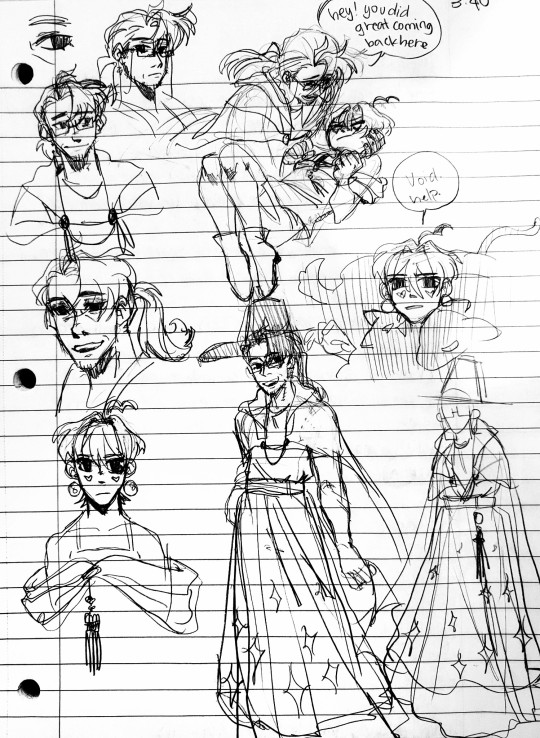

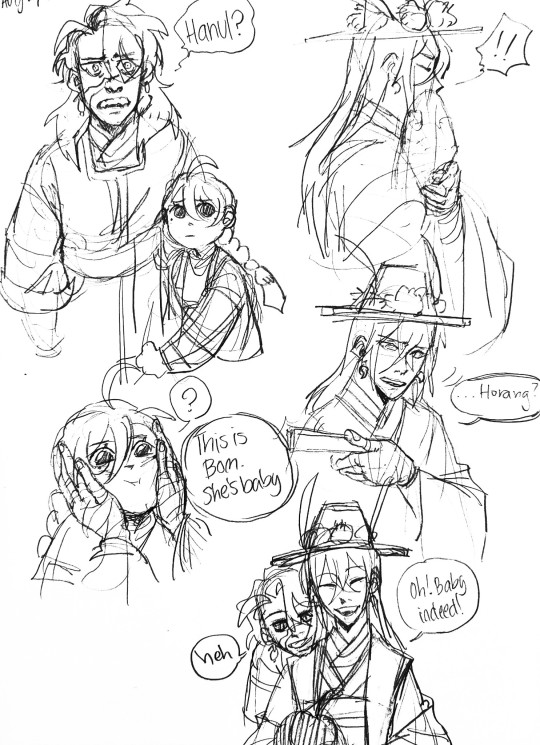

1-3 random character designs based on a dream i had where there was a kid who could fall into a void and met a kind older gentleman who taught them to harness the void's power and protect themself against their shitty family (? details blurry it was either family or a weird old man? )
4 made character in some weird distant lout of trash family au,, tis a dragon who is either sleeping or causing chaos or even both somehow
5-6 revamped doodles of an old story in which the main character, Horang, is the lone survivor of an old heroic adventure to kill the great demon. Or well, thought to be the lone survivor because they find their childhood friend and companion (Haneul) who they thought was dead. Also they adopted a tiny child (Bom) with the power of poison(? undeveloped, i have no clue what power she should have but it was seen as bad).
#basic#art#sketch#character design#alp art#alp ocs#alp horang#ok its really funny to look at my pieces and stories and realize that the more i learn about korean history the more mixed up i make#basically this is the most one where its just fantasy joseon but i dont really do much with the general aesthetic#then is plum puppet#which is MORE fantasy and fucks more with that fantasy aesthetic and also adds stuff from previous eras#then i have lati which is korean mixed with a couple other cultures because i was trying to make a new one but anyhow takes from different#periods of time without a set era im taking from but the general vibe of the whole thing is its own version of the industrial revolution???#maybe?????#then i have a new story which is dungeon crawler and isekai#flower system and it uhhh#its goryeo. but with magic (obviously) and stuff from joseon because its easy and got some cool stuff#but also guns! because its absolutely hilarious#looking at fashion inspirations is wild no matter what culture or era its from#a rabbit hole really#oh dear a return of my tag essays#its really a great format to word vomit tho its like texting
23 notes
·
View notes
Photo

Korean Grapevine & Squirrel Scroll Painting | 17th Century, Joseon period.
10 notes
·
View notes
Text
me: i'm taking this week to get in order and come back!
also me: hyperfixates on a show all week and forgets tumblr exists for a minute
#asdfgh are we surprised tho--#i couldn't help it kingdom is such a good show and!! i was technically watching it for my korean class for a culture project uvu#it just so happens that kingdom was right up my alley bc it was set in joseon period korea and had zombies!!! and very lovable characters!!#but let me stop myself from ranting about it for 30 minutes and and just say that i'm gonna work on setting up the new blog today and maybe#perhaps#write if i can :' )#happy sunday to you lovely dears and thanks as always for being patient with my silly gremlin brain <3#get ready to ramble | ooc
5 notes
·
View notes
Photo

Gu Dong-Mae & Nara Xen [Mr. Sunshine] (18+) WIP (on Wattpad)
The smut is out! LOL. There is more coming, angst and other good things, but to make it simple for all the fellow horny people, Chapter 12 is pure SMUT.
Enjoy ♥
https://www.wattpad.com/story/331270890-gu-dong-mae-nara-xen-mr-sunshine-18%2B-wip?utm_source=web&utm_medium=tumblr&utm_content=share_myworks&wp_uname=XindiChick&wp_originator=PAM9J%2BzUJ7ZXmIS04JigfcAB4SgD7cexoGbpaj7tMsx2HUP1NphJdhMSaaHhB1yjlUSVyUdbmZso1EaG5SACmmNKKkGxTmjDfbYnRb62ubGtdRIDX%2B0Q%2Brreel5c0Vhm
#angst#differentcultures#goodongmae#gudongmae#joseon#korean#mr#mr-sunshine#mrsunshine#period-piece#romance#ronin#sunshine#violence#yooyeonseok#books#wattpad#amwriting
2 notes
·
View notes
Text

🌻 here's my entry for the second week of the @tmntfashioncompetition ! the theme this time was traditional clothing and I immediately knew I wanted to do something relating to my korean culture haha
I'm going against the lovely @tizeline for this one!!
this was supposed to take place in the Joseon Dynasty, but when researching the type of hanbok people wore back then it was kinda hard finding accurate information 😭 so I just went with what I thought would suit them :]
some fun facts about this drawing under the cut! ^^
I hc that donnie would infiltrate the schools to become an astounding scholar, so when he comes home he teaches his brothers what he learned ^^ he's wearing a dopo (도포), which was what confucian scholars wore back then!
mikey's wearing a child's hanbok (한복), which are more colorful than adult ones. so technically speaking, leo and donnie should be wearing one too, but I felt that leo would want to copy don haha. plus, they all still see mikey as the baby of the group 😁
raph's wearing a gat (갓), and this is kinda where it was hard to find accurate info.. it's known that when someone wears a gat with their hair in a topknot, it signifies marriage, but other sources said that it also signifies when a child has transitioned into adulthood. either way, it represents pride, dignity, and status, so I figured I might as well add it.
and since this takes place in the Joseon period, I thought it'd be nice to have raph copying a page of the Hunmninjeongeum (혼민정음), which was a document introducing the invention of the early korean language ^^
and last but not least, the table is inspired by the one my grandparents own :]
#rottmnt#rise of the teenage mutant ninja turtles#tmntfashioncompetition#traditional garment theme#theres more fun facts but this is getting long enough haha#rise of the tmnt#save rottmnt#i think its funny that when i started researching#i ended up walking away with more info abt korean architecture than the clothes#i might as well build my own atp haha
2K notes
·
View notes
Text
*Gyeongseong Creature spoilers*
Been really enjoying this series despite the sub-par CGI (but I’ve watched enough Korean content to know that their CGI is not great so I’ve accepted it).
Perhaps this was common knowledge already (I don’t read Korean entertainment news, so I don’t know), but the allegory of the “rape of Korea” through the symbolism of the creature has been interesting to think about. In the drama, the creature is created when a Japanese scientist forces Joseon women to consume/drink the Najin—a tiny, white organism (not unlike sperm/semen)—causing them to mutate into a terrifying, vicious creature that indiscriminately kills everyone and sucks out their brains.
The creature seems to symbolize the Korean idea of “Han”/한. “Han”/한 is a concept in Korean culture, when a group or an individual has internalized trauma, sorrow, resentment, and anger from unresolved injustice, brewing for generations without resolution or a chance for one to be at peace. It’s akin to the idea of vengeance—or the deep-seated angst that compels someone towards revenge/vengeance. The concept of “Han”/한 is said to have come about during the Japanese occupation period, so it seems that the creature is a symbol of how this deeply internalized resentment and anger of feeling wronged and taken advantage of can completely mutate a person towards vengeful, bloody hatred.
I’ve read that mentioning past Japanese atrocities can get Korean actors/actresses black-listed by the Japanese government and market, and I also heard that the two leads in this drama were fully prepared for that. I had wondered why they would be willing to risk so much for a fantasy drama, but now I’m starting to realize that it might be because they believed this was an important story to tell. (I haven’t watched any interviews or anything by the drama leads so I’m speculating…). Though the creature in the drama is a fantasy, the horrible things that people did to one another during the occupation period depicted in the show are largely true. And now with the added allegory/symbolism of the creature as the “Han”/한 of the Korean people, I’m very much convinced that this drama offers much more than meets the eye.
Regardless of the political messaging, it’s a really well-made show with an ensemble cast. I’m also so impressed by the all-Korean cast learning to act in Japanese so fluently. The show is very interesting, well-acted, and Park Seo-Joon as the male lead inserts just the right amount of levity to make it entertaining but without drawing attention away from the deeper message of the film.
Can’t wait for Jan 5th when the rest of the series comes out!
91 notes
·
View notes
Text
Pre-Joseon Sageuks: a Biased and Incomplete List
So, as promised way earlier, a post on pre-Joseon sageuks that I’ve either watched or plan to watch so am aware of them. I am sure there are others but here is what I got. Obviously my takes on them are subjective blah blah blah.
Jumong - arguably the Daddy of all Traditional Sageuks, this one ran for over 80 episodes and had insane ratings. It follows the rise of the mythical founder of Gogureyo tho it takes fantastical elements of his story and changes them for historically plausible ones. It’s very long and very meaty and politics/battle heavy and has a large cast of complex characters (including pretty nifty women and a LGBTQ supporting OTP) but it is anchored by the incredible performance of Song Il Gook as the titular character as he slowly but believably grows from nothing to a hero if at the cost of losing his marriage.
The King of Tears Lee Bang Won - this is basically a half and half beast as (you can tell by the title), it’s set in the last days of Goryeo and early days of Joseon. The time period covered is the same as in My Country and Six Flying Dragons, but this is the most traditional take of them all, even more so than 6FD. Not a single pretty face in the cast (tho Joo Sang Wook is a mighty fine man, emphasis on “man”), this is for the real fans of traditional sageuks. I enjoyed it a lot but if you want to check out pre-Joseon sageuks but have mainly watched youth sageuk stuff before, you should probably start with another drama on this list.
The Great Seer - set in the reign of King Gongmin, the last proper king of Goryeo (his son King U is technically the very last but there are questions as to his status), this is for those of you who want to watch Ji Sang in a sageuk. It’s centered around seers but don’t expect mysticism, this knuckles down to politics.
Shin Don - hi there, another story set in the reign of King Gongmin! From the title, you can tel it centers heavily on the powerful monk who ruled for the King at one point. This has been on my to-watch list forever because this appears to devote a decent chunk of its time to Gongmin X Noguk and I am dying for a proper drama for those two. This is from 2005 so if you do watch, keep that in mind in terms of visuals etc. That cast is lit!
Bicheonmu - this is sort of cheating because it’s pretty much set in China but it involves Koreans so. It’s a drama take on the same story told in a pretty awesome movie. Tragic love, battles, young Joo Jin Moo etc. i am very fond of it. This said, find and watch the Chinese version, Korean one was shredded.
The Iron Empress/Empress Cheon Chu - set in Goryeo, this was another of women ruler centric dramas that had a mini popularity peak in late 00s/early 10s (a trend I wish continued.) it got overshadowed by Queen Seonduk but by all accounts is a solid drama. It’s on my list but I haven’t watched it yet.
The King’s Daughter, Soo Baek Hyang - by the writer of The Rebel and My Dearest. Have I got your attention? Another woman centric ruler tale set in Baekje. Yes, there is a love story. That cast is great, to boot. I have started and liked what I’ve seen but got sidetracked. Need to get back to it. Before you look at the ep number and faint seeing the number 108, keep in mind that the eps are half an hour long so it’s an equivalent of a normal 54 ep sageuk so if you can watch eg Empress Ki, you are good with this.
My Country: The New Age - Lee Bang Won but make it gay. OK, I kid, sort of (not really) but this is smart and passionate and heartbreaking. If you want a wide scope or lots of politics, probably not a take for you (Six Flying Dragons is RIGHT there), but if you want an intense, emotional tale, come right in!
Six Flying Dragons - to me, this is THE drama about Lee Bang Won. It’s smart and emotional, deals with politics and has heart. It has a large cast of characters I got invested in, OTPs that will blow your mind etc etc.
Faith/The Great Doctor - if you are a fan of old school shoujo like Red River, Basara or Fushigi Yuugi, this or Moon Lovers are your best bet on this list. A time traveling tale with other fantasy elements about a modern day plastic surgeon who ends up being kidnapped into Goryeo during the early days of King Gongmin’s (hi!) reign by a tormented, oath bound warrior played by Lee Min Ho at his hottest (and playing historical General Choi Young. Do RPS at your pleasure), this one is one of my all time favorites.
Seodonyo/Ballad of Seo Dong - I am actually currently watching this one tho I haven’t been posting about it. Set in both Baekje and Silla, this is an angsty love story with a side of politics. It’s filmed in 2005 and looks accordingly but if you don’t mind dated visuals, this is pretty great!
Emperor of the Sea - set in Silla and Tang, this was a huge hit and deservedly so. Our protag is a slave and gladiator and a great naval hero. This is grim and smart and epic. It’s from 2004 so once again, if dated visuals are no-go, skip, but if you want a great story and performances, this has your name on it.
The Kingdom of the Winds - an epic cursed prince narrative, our ML (Song Il Gook at his sexiest) rises from abandoned prince and slave and abused assassin to general, royal and king, sparing time for an angsty delicious love story with an enemy princess. This has serious sageuk bits AND the best shoujo tropes in the business, plus enough whump to keep anyone happy.
Gye Baek - Lee Seo Jin, another sageuk stalwart, stars as the title character in this tale of a Baekje commoner, war slave and general. This is grim but glorious.
Soldier/God of War - this is a traditional war-centric sageuk and grim as hell. Another slave to general tale.
King Geun Chu Go - this is on my watch list; it’s about a warrior king of Baekje. Haven’t seen it but heard good things.
Ja Myung Go - smart and unrelentingly tragic, featuring Jang Ryeo Won and Jung Kyung Ho as doomed lovers and Park Min Young in an evil role, this is great and has deeply flawed characters in the very definition of doomed by the narrative tale.
Arthdal Chronicles - this is obviously a fantasy but the tale of prophesied twins, magical priestess, wars and mysticism is clearly set in a pre-Joseon in terms of aesthetics world.
Alchemy of Souls - like Arthdal this is pure fantasy but also like Arthdal, a lot of its styling is pre-Joseon so on this list it goes.
Moon Lovers/Scarlet Heart Ryeo - ok I think if people have heard of only one drama on this very long list, it’s probably this one. Modern time traveling heroine ending up during the reign of Goryeo’s King Taejo, in the middle of his sons’ fight for the throne, having an epic but doomed romance with shoujo catnip tortured bad boy Lee Jun Ki.
Shine or Go Crazy - if you want a more historical take on Moon Lovers succession fight but still with plenty of hotness, angst and doomed romance, come right in. This baby stars Jang Hyuk, so you know it’s bound to be good. I actually started it and enjoyed it but got sidetracked. Need to get back to it. Fun fact: while Moon Lovers was hugely popular internationally, domestically Shine or Go Crazy (they aired around the same time), did much better.
The Legend/The First King’s Four Gods - for a long time this was my favorite kdrama of all time and is still probably in my top 10. Ignore the odd first episode, the rest is perfection. Expensive and wonderfully written, this was Bae Yong Joon’s last drama before he retired to rest on his pile of money (if you are young, you probably don’t remember what a big deal he was, bigger than all the Hallyu stars nowadays put together. He basically was singlehandedly supporting the kdrama industry at one point), but what a worthy way to go out. It’s an epic Goguryeo fantasy tale of a prophesied prince coming into his own, with such amazing characters and relationships and OTPs and battles and points about destiny versus free will. It is everything and I kinda want to rewatch now.
The Blade and The Petal/Sword and Flower - ostensibly a star-crossed Gogureyo love story, this really is more about politics. It’s a mixed bag. The visuals are insane but Uhm Tae Woong, while always solid in modern dramas, is out of place in a sageuk (in QSD Kim Nam Gil stole his thunder; there is nobody to do so here but that doesn’t help him.)
Queen Seon Duk - probably the most famous entrant into female power sageuks, this was a mad hit and centered on the titular character’s rise to power and fight for the same with her female nemesis Mishil. If you want love stories, angsty fighter Bidam propelled Kim Nam Gil to stardom as he stole the leading man mantle from Uhm Tae Woong.
Empress Ki - currently rewatching this. It’s set in the waning days of Goryeo but takes place mainly in Yuan. Still, the FL is Korean and a lot of the story revolves around one of her suitors’, a deposed Korean king, attempts to get his land back. As you can tell by my rabid posts, this is a great drama - politics, romance (I ship FL and the Yuan emperor like mad), murder, dysfunction and everything good.
Hwarang - it’s so brain dead it might as well be a brain-eating amoeba in drama form but it did give us both Park Hyung Sik and Park Seo Joon before they made it big in drama world. It’s terrible tho, stay away.
River where the Moon Rises - I have such a love/hate relationship with this drama - I loved the beginning, with our tormented assassin heroine slowly being warmed by the loyal rustic ML with his own trauma. And then Ji Soo’s bullying scandal happened and he was replaced by Na In Woo, aka the actor I like least from any country in all my close to two decades of watching dramas. I tried but I simply couldn’t and I am still mad. This said, if you don’t share my NIW allergy, it’s probably worth a watch.
The Great King’s Dream - if you liked QSD and can’t get enough of the period but want an even more traditional tale, you can do worse than this drama. I liked what I saw but this baby is 70 eps and lacks Bidam so I peaced out. Maybe I will get back to it sometime, but probably not.
Jeong Do Jeon - as you can tell by the title, centers on JDJ and the last days of Goryeo. Not really my bag (time period been done plenty in other dramas and I don’t have that much interest in JDJ) but supposed to be solid.
My Only Love Song - a short silly mess but still probably better than River (which tells the same story) because it doesn’t have NIW.
King Gwanggaeto the Great - 92 eps. I can’t!
The King Loves - delicious love triangle (that goes ALL ways), angst, prettiness, a side of bodyguard romance. What’s not to love in this Goryeo tale?
ETA: this post was so long that when I tried to tag every drama I mentioned, tumblr told me you hit the tag limit of 30 tags no more tags for you. Oh well, sorry dramas that ended up I tagged!
#kdrama#the legend#faith#my country#queen Seon duk#six flying dragons#the king of tears Lee bang Won#shin Don#the river where the moon rises#Jeong do jeon#my only love song#the great seer#empress ki#king gwanggaeto the great#shine or go crazy#moon lovers#ja myung go#emperor of the sea#jumong#the blade and the petal#alchemy of souls#Arthdal chronicles#god of war#gye baek#ballad of Seo Dong#the king’s daughter baek soo hyang#the kingdom of the winds#the iron empress#bicheonmu#the king loves
94 notes
·
View notes
Text
issues with calling or headcanoning sk as america’s child
or, a deep dive and evaluation of sk-us relations over the years as a south korean
Recently, I saw a post where someone gave their hcs of america pursuing a relationship with nk, which resulted in sk’s “birth.” then nk was afraid this new child would usurp their title and basically cause them to die, and so wanted to kill this new child before that happened. then america intervenes and “saves” sk. I believe this is the quick version of that headcanon.
I’m not trying to make this a callout post, I’m just giving my own thoughts based on experience living around US bases(Yongsan specifically)
As many have pointed out, this reeks of stereotypical “evil asian mom and chill/cooler white dad,” as well as us imperialism apologia. It also reminds me a lot of madame butterfly in a way? Additionally, it basically ignores the fact that South Korea has its own culture and existence long before US imperialism.
If the US is like sk’s “dad” in a sense, then wouldn’t that ring true for other cold war states, like south vietnam, or west germany?
I’ll leave my thoughts under the cut. This is the longest thing I’ve ever written.
CW, TW: war, colonialism, imperialism, SA, rape, murder
Primary issues with the headcanon
Throughout Korea’s history, there were times where Korea was unified, and times where Korea was not. There have also been splits of different states, north and south. I point to the Kingdoms of Goguryeo and Silla during the Three Kingdoms Period, and even before then with Gojoseon and Jin. So this split is not exactly new, and this is why I personally disagree with the headcanon that North and South Korea were babies around the time of the split, and rather that they represented Goguryeo and Silla.
The Korean War had stemmed from a desire to reunite the two states. Kim Il-Sung had pursued this and that started the war, and even Syngman Rhee pursued this ideal as well after the UN forces recaptured Seoul, resulting in that further push to invade North Korea. But this desire would have never existed if they weren’t split to begin with and remained whole as they did since 700 years ago with the establishment of the Joseon Dynasty. The Korean War was not willingly fought by both South and North Koreans.
It was a result of imperialist states splitting us up and then pitting us against each other(even the split was quite hasty, with families being split across the border), so it’s also wrong to draw parallels of SK fighting for its existence in the Korean War and the US during the Revolutionary War. One was fought to stay alive as a nation, and of which can be traced to outside forces laying their influence on the Peninsula, and one was fought willingly and of their own accord.
So it’s important to remember that the War was not because of an attempt to kill a “child” made by North Korea and America, it was the result of a nation that has been unified as one for 700 years being split suddenly, and the desire on both sides to reunify, albeit under their own management. Additionally, the idea of South Korea being “a child” of the US ignores the centuries-worth culture and history that was not influenced by the US and propagates the idea that we belong in the US’s shadow, and that without them, we have no identity.
South Koreans affectionately refer to the US as our “brother state,” but never think of the relationship as a parent and child. Remember that.
Next, we’ll talk about the role of the US in this.
While doing some research into the split, I found that after Korea was liberated in 1945, a socialist government(People’s Republic of Korea) was organized and supported by the majority of the population. This made the most sense. There was a vast gap of inequality between the Korean peasants, and the Korean nobles(who were given/maintained that power by betraying their Korean identity and working with the Japanese), so they advocated for social reform, such as land reform. However, the US wanted to set up their own military government(which for some time had actually supported the Japanese colonial government). So the US censored and then outlawed the popular government, putting themselves in charge and keeping advisors such as former Japanese colonial officers, wealthy landowners, and businesspeople. You know, the exact people the popular government was against?
This government then set up elections. The majority of Koreans didn’t want that, because they knew that these elections would divide the country and leave no hope of unifying. So they protested, but they were put down by police and the US military. It might also be worth it to read about the Jeju Massacre, in which Jeju people protesting the UN-backed elections were brutally suppressed by Syngman Rhee and the US Military. This killed about 10% of Jeju’s population. Though the South Korean government has issued an apology, we have yet to hear from the US.
So the US set up a government that supported a military dictator(it started with Syngman Rhee) and continued to support a long chain of these military dictators(who sent pro-democratic people to concentration camps) even during the Gwangju Massacre, when many pro-democratic students protested against the dictatorship and the then-president Chun Doo Hwan responded by commanding the military and police to fire on citizens. Though official government figures place the deaths at 200 people, citizens of Gwangju say it’s closer to 2000 people.
I only found out about the concentration camps this year, and it’s because the South Korean Government, who wants to stay on the US’s good side, actively represses the role of the US in the military dictatorship. I’m pretty sure the US’s role is also barely taught in Korean history textbooks, since the government has tried to rewrite and issue textbooks themselves.
Recently, the grandson of Chun Doo Hwan(the president that ordered the military to shoot on the protesters, and also was supported by US Presidents Carter and Reagan), apologized on behalf of his grandfather and family, who had constantly told him it was just a riot when he was a kid. He also took the time to expose his family, friends, and even his own money laundering crimes. He personally visited Gwangju and gave a full floor-level bow in apology. This was a first step in the correct direction. However, the government, especially with Yoon Seok Yeol’s pro-US and anti-NK sentiment, is trying not to shed light on these issues, and it’s why I believe a lot of people tend to continue to favor the US, because they don’t really know or are aware of the US’s full part in our military dictatorship.
Another interesting read would be the Namyeong-Dong Anti Communist Investigation Office, a former prison facility and torture room for pro-democracy protestors.
Now for the existing US impact on South Korea: The USFK
The USFK(short for United States Forces Korea) is the Korean branch of the US Military. They have an active presence in South Korea since 1957, which is about 65 years ago.
Not many Koreans have an Anti-American sentiment, but the USFK has consistently caused it to resurge throughout the nation.
In 2000, it was found out that the US military had dumped about 20 gallons(75L) of formaldehyde into the Han River, which at the time was a main drinking source for about 12 million people in Seoul.
They carelessly ran over two 14-year old girls(Shin Hyosun and Shim Miseon) with one of the US military’s armored vehicles in 2002. What made things worse was that the US Military Court found them not guilty. In response to the incident and other grievances with the US military, PSY actually rapped a song called “Dear American” written by a South Korean band criticizing them, mostly regarding the US military and their involvement in the Iraqi War, which he later had to apologize to the US military for rapping after he got famous singing Gangnam Style.
The US military was also involved in forced prostitution and human trafficking. In 1992, Yoon Geum-i, a military sex worker, was raped and killed brutally by Private Kenneth Markle. He was tried and initially received life in prison, but then later his sentence was reduced to 15 years in prison after Yoon Geum-i’s family received $72,000 as compensation from the US government. In 2006, he was released on parole and then deported to the US. @tianshiisdead further goes into detail on this on her post about these headcanons.
In 2020, it was found that the major camp of the USFK, Camp Humphreys, was hosting a no mask COVID party while the Korean government was urging locals to limit in person gatherings as the cases were surging. The party was on a Friday, and on Monday it was found that 408 USFK-affiliated individuals tested positive for COVID.
The South Korean government pays them to stay here... and do what? Cause trouble?
The USFK and US funding the ROK military has led to the ROK military being one of the strongest. However, we are not allowed our own weapons, and the US constantly attempts to provoke North Korea through any presidential remarks, or actions. This keeps South Korea reliant on the US, and allows for a continued presence in South Korea.
Conclusion
All of this is why it’s so important to keep checking back on how you see Korea and America’s relationship in Hetalia. As positive as current relations may be, it’s important to remember the many failures on the US’s part to keep their military acting like decent human beings at times, and that they literally caused the split along with the USSR, and made it permanent through the suggestion and implementation of elections, which Koreans on both sides largely did not support.
South Korea has one of the highest positive perception rates towards the US. This may be due to their hand in helping us develop as a nation and also providing aid during the Korean War, but it may also be due to the suppression of the full extent of activities the US has partook in South Korea, and due to the Anti-North Korea sentiment that was also propagated by the US.
Also, the fact that Americans also call the Korean War “The Forgotten War” is so frustrating to me. Did we just... not matter in the long run? We’re just a pawn, or a strategic location, right? The separated families, the civilian casualties(which was a higher rate than WW2′s and the Vietnam War), the devastation of so many cities... just didn’t matter? Maybe you forgot, but it’s impacted us and our decisions for years. Just goes to show how selfish the US can be...
As much as I do wish one of my favorite ships were one of complete happiness where nothing is wrong, this is not the case, and I am trying my best to express that in art or headcanons. It is important to acknowledge that the 70-year long relationship, though sharing some positive, unproblematic moments through cultural exchange and joint collaboration in the modern era, is characterized by a lack of trust on South Korea’s end, largely due to how the US has wronged us over the years.
#hetalia#disk horse#aph south korea#aph north korea#aph america#im yong soo#im soo jin#im hyung soo#alfred f jones#i used to live near a US base#ever since i was a kid i always wondered what was there#then i saw and there were... large american style houses???#it was like i somehow was in a us suburban neighborhood in korea#the government pays for them to have these big ass houses#yet a lot of koreans struggle with rent issues and the housing crisis#i find that very interesting#it's also super annoying that they don't learn korean and then get into situations#frick around find out#amekor#kimchiburger#hws america#hws south korea#hws north korea
150 notes
·
View notes
Text





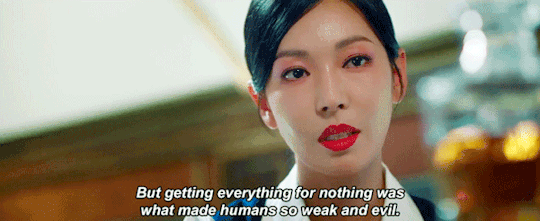
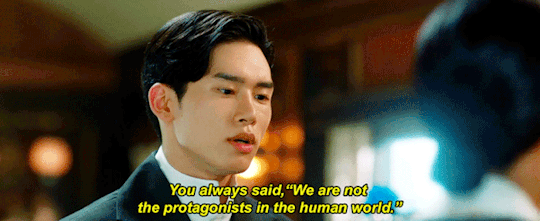


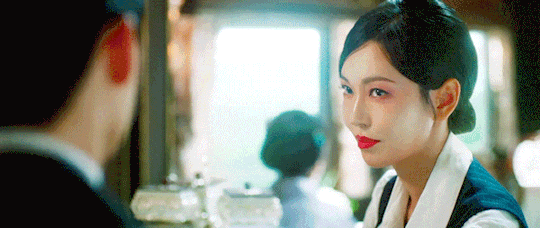
야견박살령 / Wild Dog Massacre Order
Dogs were slaughtered by the Japanese government in occupied Joseon, officially to counter rabies from unregistered dogs, but actually to obtain fur and leather for war supplies for the Japanese army.
Donggyeongi dogs were killed for leather and because the Japanese believed they resembled Komainu [temple-guarding dog statues]. Even after Liberation in 1945, the dogs' short tails were seen as bad luck, and the breed fell out of favour.
Sapsaree dogs, whose name means “the dogs that ward off evil spirits or misfortune” are shaggy-haired dogs that were killed in large numbers by the Japanese military, which used their fur to make winter coats. By the mid-1980s, only eight remained.
Jindo dogs were comparatively spared because of their resemblance to the Japanese Kishu dog.
During the occupation period, most native Korean dog breeds were pushed to extinction.
Until 1945, over 1.5 million dogs were slaughtered.
[X][X]
Tale of the Nine Tailed 1938 | Episode 05
#tale of the nine tailed 1938#tale of the nine tailed#kim so yeon#han gun yoo#yoo jae yoo#ryu hong joo#ryu hong ju#kdrama#kdramaedit#kdramadaily#gumihodyeon#gumihodyeon 1938#history#korean history
170 notes
·
View notes
Photo
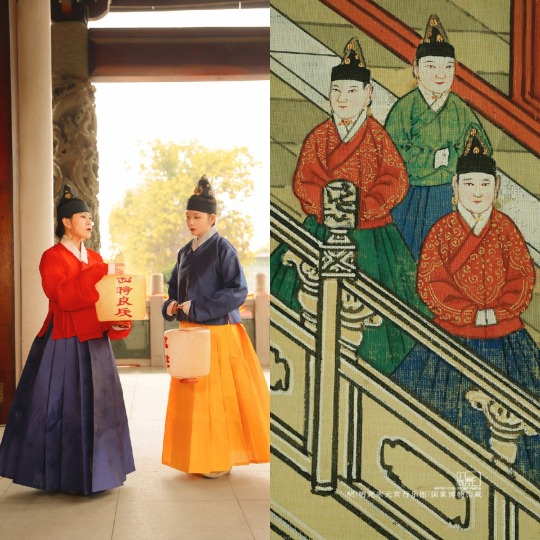
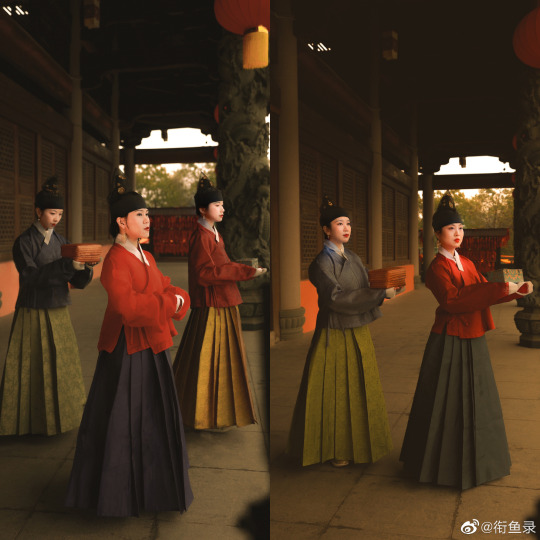



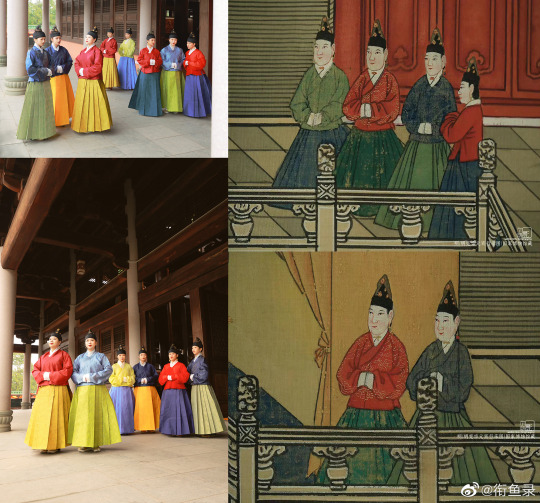

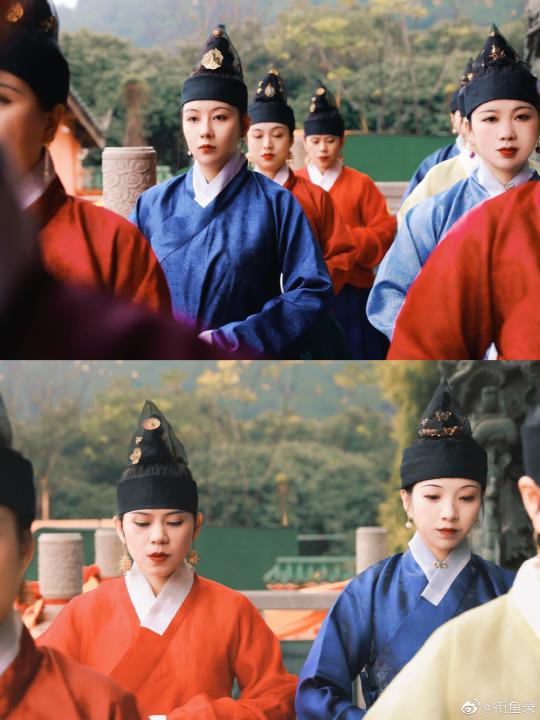
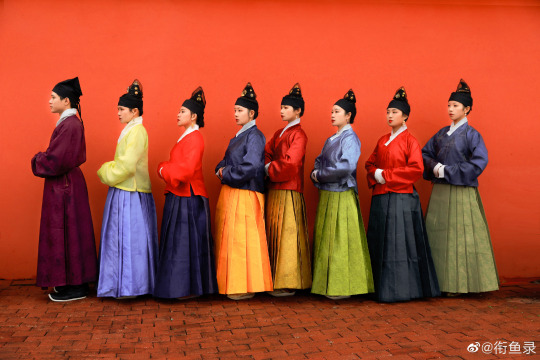
【历史文物参考】
Chinese Ming Dynasty Painting(1485 CE):【明宪宗元宵行乐图/Ming Emperor Xianzong Enjoying the Lantern Festival (part)】showing court lady in the ming dynasty
※ Women with gold patterns in Hanfu (top) had titles/rank in the court of the Ming Dynasty, and they may be imperial concubines, princesses, etc.
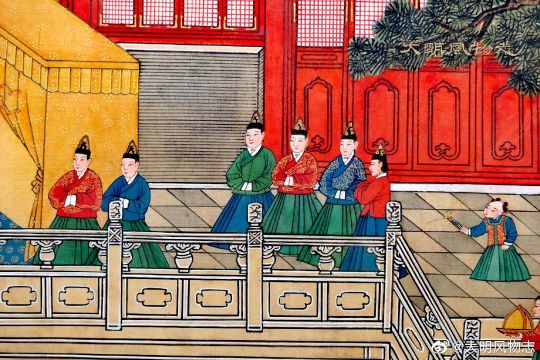
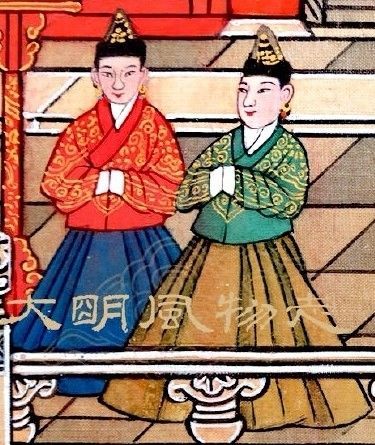




[Hanfu · 汉服]Chinese Ming Dynasty Chenghua era(1465-1487 AD) Traditional Clothing Hanfu & Hairstyle
【About horsehair skirt (马尾裙) petticoat】
A horsehair petticoat (马尾裙) is a petticoat that is worn under the skirt to give it a puffy appearance. This kind of petticoat came from Korea Joseon at that time.
❗ However, it would be wrong to say that the entire outfit above is Korean origin as someone claim.
In Ming Dynasty record "寓圃杂记/Yu Pu Notes" By Wang Kai王锜 emphasizes that this style of clothing (马尾裙horsehair petticoat) is a kind of ominously strange clothing , which is what the ancients called "服妖(A derogatory term that describes people wearing weird clothing is bad symbol)". It is only popular among rich and uneducated people, and will let decent people look down on, the original words are " 然系此者惟粗俗官员、暴富子弟而已,士夫甚鄙之,近服妖也 "
Horsehair petticoats are popular in Beijing. Demand was low at first, and local production was impossible and unnecessary. They are all imported from Korea Joseon. When it becomes popular, even men like to wear horsehair petticoats under their robes, and the demand and market will naturally increase, so localized production began. But the number of horses is limited, and the most important raw material, horse hair, is not easy to obtain.
So some people went to the army camp to steal the horse hair of the army horse, which made the army horse look thin and bad.
❗In the Early Emperor Hongzhi era,the officials reported these incident to the Emperor Hongzhi(1470-1505)of the Ming Dynasty said”京中士人好著马尾衬裙,因此官马被人偷拔鬃尾,有误军国大计。乞要禁革”Saying that such behavior is not good for the country and suggest to ban horsehair petticoat. So Emperor Hongzhi make an order to banned people wearing Horsehair petticoats
Since then, this horsehair petticoat gradually disappeared from China history
❗ It is worth mentioning that even in the period when horsehair petticoats were popular, not everyone wore horsehair petticoats, as shown in the book "释氏源流应化事迹" in the Chenghua era of Ming Dynasty (AD 1465-1487): ( Women that not wear horsehair petticoats)
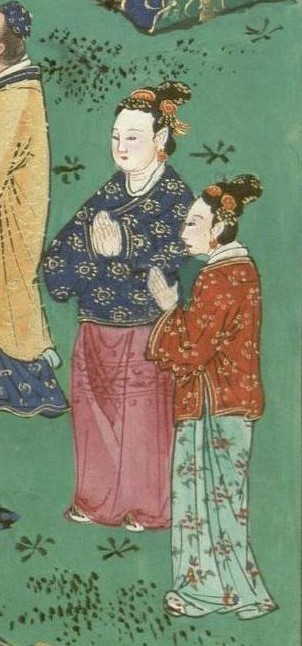
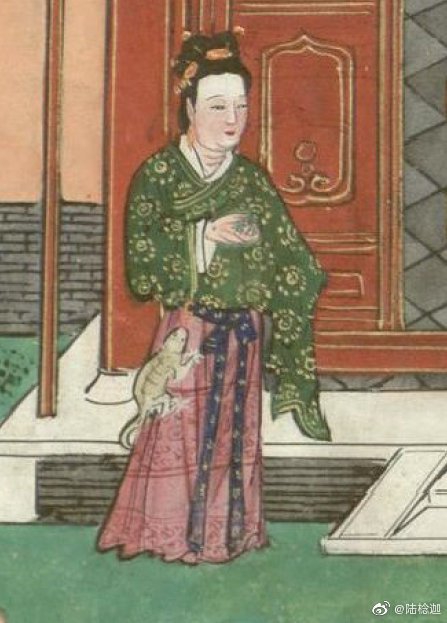

After Emperor Hongzhi banned the wearing of horsehair petticoats (back to the silhouette of Hanfu in the Ming Dynasty), as shown below
Murals in the tomb chamber of Zhengde period (1506-1521) - Jiajing period (1522-1566)::

_______
💡 Produce: @衔鱼录
📸Photo: @超级方便MAN
🎥Post-production : @还是叫我雪影吧
🔖Hanfu Research: @玩泥巴的豆角 @邈邈阁的颜掌柜
🧚🏻 Model : @还是叫我雪影吧 @曾嚼子 @记不住密码的小基崽 @NanFu_南赋吖 @玩泥巴的豆角 @纭澈 @言言衍晏 @子可_POTTERY @祁祁萝祁萝贰祁
💄Makeup Director: @还是���我雪影吧
🧵Tailor: @邈邈阁的颜掌柜
🏮Lantern provider: @纭澈
CC organization: @南宁汉服小组 @汉洋折衷bot @大朙时尚搭配频道 @大明穿搭bot @说给大明服饰
🔗微博:https://weibo.com/3962795866/MrDftbHIT
_______
#chinese hanfu#Ming Dynasty Chenghua era(1465-1487 AD)#hanfu#chinese traditional clothing#chinese fashion history#China History#chinese#historical fashion#historical hairstyles#Chinese Costume#chinese culture#hanfu accessories#hanfu history#Zhengde Emperor era(1506-1521)#Jiajing Emperor era(1522–1566 A.D)#《释氏源流应化事迹》#寓圃杂记/Yu Pu Notes#明宪宗元宵行乐图/Ming Emperor Xianzong Enjoying the Lantern Festival#汉服#漢服#Horsehair petticoats
300 notes
·
View notes
Text



Book Review of A Crane Among Wolves by June Hur (허주은)
Summary: Hope is dangerous. Love is deadly.
1506, Joseon. The people suffer under the cruel reign of the tyrant King Yeonsan, powerless to stop him from commandeering their land for his recreational use, banning and burning books, and kidnapping and horrifically abusing women and girls as his personal playthings.
Seventeen-year-old Iseul has lived a sheltered, privileged life despite the kingdom’s turmoil. When her older sister, Suyeon, becomes the king’s latest prey, Iseul leaves the relative safety of her village, traveling through forbidden territory to reach the capital in hopes of stealing her sister back. But she soon discovers the king’s power is absolute, and to challenge his rule is to court certain death.
Prince Daehyun has lived his whole life in the terrifying shadow of his despicable half-brother, the king. Forced to watch King Yeonsan flaunt his predation through executions and rampant abuse of the common folk, Daehyun aches to find a way to dethrone his half-brother once and for all. When staging a coup, failure is fatal, and he’ll need help to pull it off—but there’s no way to know who he can trust.
When Iseul's and Daehyun's fates collide, their contempt for each other is transcended only by their mutual hate for the king. Armed with Iseul’s family connections and Daehyun’s royal access, they reluctantly join forces to launch the riskiest gamble the kingdom has ever seen:
Save her sister. Free the people. Destroy a tyrant.
Review: [Cruel tyrant is not an exaggeration so there is a content warning in the author's note that indicates the following: rape (mentioned), sexual abuse, misogyny, kidnapping women and girls, sex trafficking, incest (mentioned), violence, murder, animal cruelty, suicide (mentioned), infanticide (mentioned), psychological trauma, and panic attacks.]
Though this story is fiction, the setting and King Yeonsan are part of actual history. June Hur has not tidied up his tyrannical behavior so there are a lot of atrocities to witness in Iseul and Daehyun's path. This does make for a difficult read, but there is also love and strength that shine through. The dedication says, "To those who have dared to be a beacon of light in the bleakest of moments." There are numerous characters who are that light for others and even in the midst of so much awfulness, there is hope. That's what kept me reading.
Iseul's life has turned upside down and she has realized that she had taken her sister for granted. She is out on her own for the first time and is making brave and rash decisions because she seemingly is unaware of how truly risky and deadly her choices might be. Watching some of her actions is hard, but as she stumbles and begins to find her feet, she is also making connections with some folks who are those beacons of light.
It is equally troubling to watch Daehyun make decisions when there really are no actions to choose that feel truly right. My heart was with both of them knowing that they really were doing the best with their circumstances even when there were no good options. And even when they pick a way that seems best, there is endless frustration as they continue to face horrifying loss and disappointment. Many characters in this story, in addition to so many Korean people in that time period, dealt with a feeling encompassed in the word han. In the book it's described as the "feeling of outrage, the vicious urge for vengeance to right the wrong, pierced by the acute pain and grief of knowing our overwhelming odds at ever claiming justice."
Yes, the odds seem overwhelming, but Iseul, Daehyun and their allies continue to fight, sacrifice, and are willing to give their all to try anyway. They are all inspired by the Korean people, their families, loved ones, and the hope of creating a more peaceful place for all. Some of these allies are so wonderful and even though they are side characters, they managed to worm their way into my heart too. In the midst of all of the effort of so many people, there are also intrigues and mysteries to puzzle out so it's definitely a page turner.
Recommendation: Get it now. For those who watch historical K-dramas already, this will definitely be a must read. For others, this will appeal to anyone who enjoys history with some romance and political intrigue. Though it shows a lot of trauma and hardship, June Hur also provided characters that will touch hearts and stay with readers for a long time to come.
Extras:
youtube
Publisher: Feiwel & Friends
Pages: 368
Review copy: Digital ARC via publisher
Availability: On shelves now
21 notes
·
View notes
Photo
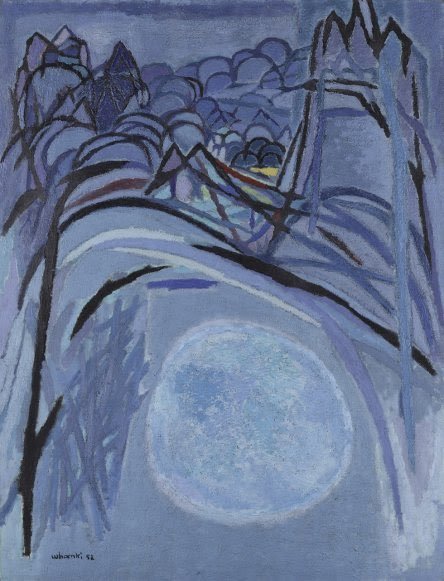
Mountain & Moon, Kim Whanki
Audio Commentary by Kim Namjoon
Transcription
In the 1930s, Kim Whanki studied in Japan, where he worked and became close with many Japanese avant-garde artists. After establishing himself as one of Korea’s first abstract artists, Kim began incorporating elements of traditional Korean culture into his paintings, starting in the late 1940s. He produced many works featuring modernized expressions of popular motifs from the Joseon period, such as mountains, plum blossoms, and white porcelains, especially moon jars.
In 1956, three years after the Korean War, Kim moved to Paris, where he stayed for three years. In France, even though he was immersed in the new trends of Art Informel and Nouveau Réalisme, he continued to develop his own unique style.
It was in Paris that Kim painted Mountain and Moon, which captures a theme that was very dear to his heart: the natural landscape of Korea. The work combines both figurative and abstract characteristics, with an accumulation of geometric shapes and lines forming a discernible image of mountains and the moon. In the upper part of the canvas, thick brushstrokes represent mountain ridges, while the lower half of the painting is dominated by a round full moon. The white color of the moon is evocative of Joseon moon jars, but the overall tone of the painting is blue, the color that became increasingly prominent in Kim’s palette as his career progressed.
#Kim Whanki#mountain & moon#art#paintings#blues#korean art#the space in between#the modern in korean art#art history#history#lacmamuseum#lacma#rm#kim namjoon#bts#rm audio commentary#rm narrations#moon
413 notes
·
View notes
Note
When do u think the modern personification of Korea was born? Cause there is the kingdom of Goguryeo which place Korea at like 4000(but like would it be like a china situation where it’s the same personification who’s just stupidly old or like Greece and Egypt where they had an ancient version) there’s also the three kingdoms period which started about 2000 years ago. Or there’s even the more modern eras like Joseon. I’m just curious how old u see the current personification as.
*Gojoseon I accidentally typed the wrong G kingdom. Goguryeo was later on. Sorry for any confusion
thanks for the question! this is my personal take on it: yong-soo is at least 2000 years old; he thus dates back to the three kingdoms period rather than to gojoseon. i do think there's always some wiggle room with the age of a personification and how we interpret history so i can see other variations; my main hard no is making him too young (such as born after the 1950 korean war...please no).
contemporarily, yong-soo represents south korea, but in the beginning, i see him as the old korean kingdom of silla. nations don't suddenly spring into existence overnight, so while silla was was officially founded in 57 BCE, he's probably older than that. that's just the latest date i see him being around by. yong soo, imo, also has/had at least two brothers: goguryeo (who later represents north korea after wwii) and baekje, who was kiku's close ally—as per how, in real history, the kingdom of baekje and yamato japan had quite an important alliance. baekje dies by a combination of yong-soo and yao's actions after the baekje-tang war—as per how baekje got annexed into the kingdom of silla, and china crushed the japanese forces attempting to support baekje restorationists at the battle of baekgang. i don't think yong-soo necessarily wanted his brother to die, but it was a power struggle, and those have consequences (as tang dynasty yao would probably say coolly, while seated atop his war horse...😔)—nations mirror humans, and how often have royal houses across different cultures warred against family members throughout human history? so, it's kind of sombre but there were once three brothers.
overall, i see yong-soo as an old nation who's lived many lives before his present incarnation as the republic of korea (and in the east asian cosmology; reincarnation is quite a familiar concept for us). i see him being older than kiku, and he's the one who taught kiku advanced shipbuilding and navigation, as a reflection of how mariners/shipbuilders from silla influenced japan. this is naturally very ironic from the meiji era onwards, particularly when korea comes under japanese colonial rule, and kiku refashions himself as a 'modern' naval power. so, rather than the canon dynamic that seems to posit a rather youthful yong-soo vs. old man china and japan...imo it's really Old Men Wrestling with the Confucian Hierarchy All the Way Down (even if Yong-soo's skincare regimen means he looks good and he is skilled at putting on a friendly and youngish persona if need be). one implication that's important to me about yong-soo's age is exploring how he and kiku (and also yao) have a very old relationship that runs deep due to all that history and cultural exchange, but it is naturally, far from easy.
32 notes
·
View notes
Text








[Atelier Lena] Korean Gulle Hat (Infant & Toddler)
- New Mesh
- All lods
- All 11 Swatches
- Hat Category
A gulle(굴레) is a type of sseugae (쓰개), Korean traditional headgear, worn by children aged one year (called dol) to five years old during the late Joseon period. It was mostly worn by young girls in the upper class for warmth and style.
Always thank you for your supporting💖
-T.O.U-
Don't modification & (re)distribute my contents file.
DO NOT RESALE MY CC
DO NOT RE-UPLOAD ANYSITE
Do not re-color without my permission.
Do not claim as your own.
Do not convert my contents to another game.
This item (HANBOK) is KOREAN TRADITIONAL CLOTHING, not other country's. 🇰🇷
When you downloading, it is considered to agree to the T.O.U.
DOWNLOAD << Public on June 2023.
#ts4#sims 4#sims 4 cc#sims 4 korean cc#sims 4 korean#sims 4 hanbok#ts4 cc#sims 4 hanbok cc#sims 4 infant#sims 4 toddler#sims 4 infant cc#sims 4 toddler cc
93 notes
·
View notes